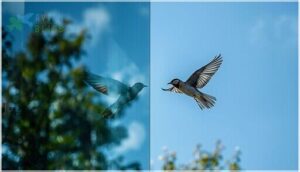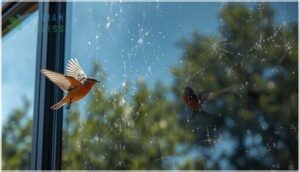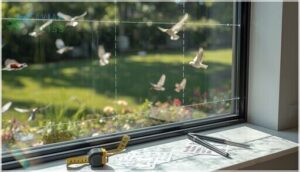This site is supported by our readers. We may earn a commission, at no cost to you, if you purchase through links.
You might think that a bird approaching your window would simply see the barrier and veer away, but this assumption has contributed to nearly one billion avian deaths annually in North America alone. Birds don’t see glass the way you do. Their visual system, despite being remarkably intricate in many ways, lacks the biological framework to detect transparent or reflective surfaces as solid obstacles.
While birds possess tetrachromatic vision that allows them to perceive ultraviolet wavelengths invisible to humans, this evolutionary advantage becomes a fatal liability when confronted with modern architecture. Understanding why their superior eyesight fails them at windows reveals not just a gap in avian perception, but also points toward practical solutions that can dramatically reduce these preventable collisions.
Table Of Contents
- Key Takeaways
- Can Birds See Glass?
- Why Birds Collide With Windows
- Architectural Features That Endanger Birds
- Making Glass Visible to Birds
- Strategies to Prevent Bird-Glass Collisions
- Frequently Asked Questions (FAQs)
- What do birds see when they look at glass?
- Can birds learn to see glass?
- Can birds see dirty glass?
- How do you make glass visible to birds?
- How do different bird species vary in glass perception?
- Can birds learn to avoid windows over time?
- How does a birds age impact its glass recognition?
- Are some colors more effective for window markers?
- Can bird feeders be positioned to prevent collisions?
- What happens to injured birds after window strikes?
- Conclusion
Key Takeaways
- Birds can’t see glass because their tetrachromatic vision relies on ultraviolet light that standard glass absorbs, making transparent and reflective surfaces essentially invisible to them despite their superior visual capabilities in other contexts.
- Nearly one billion birds die annually in North America from window collisions, with low-rise buildings between 4 and 11 stories causing 56% of strikes—particularly during migration seasons when unfamiliar birds traverse urban corridors.
- Simple pattern spacing of 2 inches horizontally and 4 inches vertically on windows reduces collisions by 95-100%, with treatments covering just 7% of glass surface proving as effective as denser patterns when properly applied to exterior surfaces.
- Strategic interventions like bird-friendly legislation, Lights Out programs during migration seasons, and targeted homeowner solutions focusing on high-risk windows near vegetation can reduce strikes by 80-97% without requiring wholesale architectural changes.
Can Birds See Glass?
You might assume birds see the world much like you do, but their visual system operates on an entirely different wavelength—literally.
Understanding how avian eyes process light and perceive obstacles like glass reveals why millions of birds collide with windows each year.
Let’s explore the key factors that make glass such a hidden danger for our feathered neighbors.
How Birds’ Vision Differs From Humans
Your eyes and a bird’s eyes see the world in remarkably different ways. Avian eye structure includes four types of cone cells—one sensitive to ultraviolet light—giving birds tetrachromatic vision. This ultraviolet sensitivity means they perceive colors you can’t even imagine.
Their visual acuity often surpasses yours, yet depth perception works differently. Most birds rely on monocular vision with limited binocular overlap, affecting how they judge distances.
The differences in visual systems, including avian eye structures, play a significant role in understanding bird behavior.
Scientific Studies on Bird Perception of Glass
Bird vision research reveals a troubling reality. In behavioral tunnel experiments, birds fail to distinguish untreated glass from open air—they simply don’t perceive it as a barrier. Glass reflection studies confirm that avian vision can’t detect standard glass transparency because it absorbs ultraviolet light birds normally rely on.
Birds cannot see glass as a barrier because their vision relies on ultraviolet light that standard glass absorbs
Window treatment efficacy data shows marked glass reduces window collisions markedly, pointing toward bird-friendly materials as practical solutions backed by avian collision data. The implementation of bird friendly designs can greatly reduce the number of bird collisions.
Myths and Misconceptions About Birds and Glass
You might assume evolution will eventually teach birds to avoid glass windows, but collision data tells a different story. Glass technology renders windows invisible to avian vision—it’s not about intelligence or fitness.
Strong, healthy birds strike birdfriendly materials-free surfaces just as often as weaker ones. Urban planning and wildlife conservation efforts must recognize this: bird collisions aren’t natural selection at work.
Why Birds Collide With Windows
Glass poses a deceptive threat that you mightn’t immediately consider from a bird’s perspective. Several factors work together to make windows nearly invisible to avian eyes, turning ordinary buildings into collision hazards.
Let’s examine the three primary reasons birds fly into glass.
Transparency and Reflection Issues
Have you ever noticed how glass windows can mirror the sky so perfectly they seem to disappear? That’s exactly what birds experience. Transparent barriers create the illusion of open flight paths, while reflective surfaces trick birds into seeing habitat that isn’t there.
Key factors affecting bird collision risk:
- Mirrored and tinted glass causes up to 50% more bird collisions than clear glass
- Reflective glass visibility peaks during sunrise and sunset
- Darkened interiors intensify exterior reflections, worsening window safety
- Modern transparent glass windows remain invisible without bird-friendly materials
Understanding these transparency and reflection issues is your first step toward effective window collision prevention.
Lack of Visual Cues and Depth Perception
Unlike humans with 120° of binocular vision, most birds possess only 20-30° of binocular overlap—limiting their depth perception directly ahead. This narrow field means birds need roughly 10% contrast to detect obstacles, compared to just 0.5% for you.
Without door frames or structural visual cues, experimental studies confirm birds can’t distinguish clear glass from open air, increasing collision risks and reducing glass visibility during flight.
Environmental and Seasonal Factors
You’ll notice collision peaks concentrate during migration season—March through June and August through November—when favorable weather conditions and climate change reshape avian migration patterns. Spring brings warm dawn temperatures and south winds, while autumn sees cold mornings with high pressure systems driving southward movement.
These seasonal risks intensify as habitat fragmentation forces migrants through urban corridors, where environmental impact multiplies bird-window collisions during narrow 15% windows of peak activity.
Architectural Features That Endanger Birds
Not all buildings pose the same threat to birds. Certain design choices—from the type of glass used to where a structure sits in the landscape—dramatically increase collision risks.
Let’s examine the specific architectural features that turn everyday buildings into unintended hazards for migrating and local bird populations.
Problematic Glass Designs and Materials
Certain glass configurations turn your building into a collision trap for birds. Mirrored windows create deceptive reflections that multiply collision risk by nearly four times, while large transparent panels and glass corners present invisible barriers birds can’t detect.
Three design elements pose the greatest danger:
- Glass atriums and see-through corridors that birds interpret as flyable pathways
- Reflective surfaces facing vegetation where mirrored trees and sky create deadly illusions
- Untreated conventional glazing lacking acid-etched and fritted glass or other bird-friendly glass treatments that make windows visible
Studies confirm that bird-window collision prevention starts with recognizing these architectural hazards.
Impact of Building Location and Height
Where your building sits makes all the difference. Low-rise structures between 4 and 11 stories cause 56% of bird collisions, while urban buildings account for 56% of all avian mortality despite rural areas’ cumulative threat.
Buildings near migratory flyways, water bodies, or wooded areas become collision hotspots—especially during migration patterns when glass surface area and building height risks intersect with concentrated bird traffic, making bird-friendly building design essential for window collision prevention.
Role of Nearby Vegetation and Urban Settings
Vegetation within 50 meters of glass creates a deadly illusion—birds see reflected trees as habitat, not hazard. Studies show collision rates increase 2.3-fold near dense urban vegetation, particularly during bird migration when ecological impact peaks.
Your building’s relationship with greenery matters:
- Vegetation reflected in glass doubles collision frequency
- Fruiting trees increase winter strikes 3.33 times
- Urban planning setbacks reduce collisions 47%
- Window treatments with birdfriendly design cut strikes 84%
Strategic collision mitigation through sustainable urban planning and glass reflections management protects urban wildlife management efforts.
Making Glass Visible to Birds
Once you understand why birds can’t see glass, the next step is helping them detect it before they collide.
Several proven methods can make windows visible to bird vision without blocking your view or requiring major renovations. The key is choosing treatments that break up reflections and provide visual cues birds can recognize from a distance.
Window Decals and Visual Patterns
You can prevent collisions by applying visual markers to your windows—decals, UV-patterned glass, and acid-etched or fritted glass all work.
Pattern designs matter: space elements no more than 2 inches apart, with each marker at least 0.25 inches wide. High-contrast colors increase bird safety, and window film technology using ultraviolet patterns achieves up to 71% decal effectiveness in bird-window collision prevention when installed correctly.
Bird-safe Glass Treatments and Films
Modern window film technology delivers measurable collision reduction when applied correctly—exterior installation is critical. BirdShades ultraviolet patterned glass treatments increased bird-friendly glass avoidance by 47%, while Haverkamp films achieved 39% effectiveness. Interior applications fail entirely. Field studies confirm 90-94% fewer collisions after retrofit, with glass coatings and acid-etched and fritted glass alternatives meeting bird-window collision prevention standards.
Why window treatments save lives:
- You’ll protect migratory birds traversing unfamiliar urban landscapes
- Your home becomes part of the conservation solution
- Pattern designs tested in real conditions prove their worth
- Film effectiveness transforms deadly reflections into visible barriers
- Every treated window means fewer preventable deaths
Effective Pattern Placement and Color Choices
Your pattern spacing determines everything—elements placed 2 inches apart horizontally and 4 inches vertically reduce bird-window collision prevention failures by 95-100%. Color selection matters less than contrast, though ultraviolet patterned glass helps UV-sensitive species.
Covering just 7% of glass with properly spaced markers works as well as denser patterns. High-contrast decal durability ensures long-term effectiveness, with quality glass treatments maintaining bird-friendly glass standards beyond five years.
Strategies to Prevent Bird-Glass Collisions
Reducing bird-glass collisions requires action at multiple levels, from city planning to individual homeowners. The most effective strategies combine architectural design changes, seasonal lighting practices, and accessible solutions that don’t require extensive renovations.
Here are three practical approaches you can implement to protect birds in your community and at home.
Bird-friendly Urban Design and Legislation
Cities across North America are embracing bird-protective legislation and bird-friendly urban planning to address collision mortality. You can find inspiration in these legislative frameworks shaping sustainable design:
- New York City’s Local Law 15 requires bird-friendly materials on 90% of facades up to 75 feet
- Washington D.C. offers subsidies for bird-safe retrofits
- Maryland ties bird safety to LEED certification
- Federal agencies provide bird-friendly design guidelines
- Over 20 U.S. municipalities have adopted bird conservation efforts
These green infrastructure policies demonstrate that urban planning and bird safety aren’t mutually exclusive—they’re complementary goals in bird-friendly building design.
Lights Out and Migration Season Practices
Beyond legislative frameworks, you can take direct action through Lights Out programs—a simple yet powerful Window Collision Prevention Methods approach. During migration season (March through June, August through November), billions of birds navigate using starlight, but light pollution disrupts their journey.
Research from Chicago shows that dimming non-essential building lights between 11 p.m. and 6 a.m. reduced bird strikes by 80%. Lights Out DC and similar initiatives demonstrate how urban sustainability aligns beautifully with bird conservation and energy efficiency, protecting bird migration patterns one switch at a time.
Homeowner Solutions and Cost-effective Approaches
For your home, cost-effective solutions don’t require treating every window. Focus your retrofitting efforts on high-risk panes—those reflecting vegetation or positioned near feeders. DIY window films and bird-friendly materials deliver outstanding results:
- Adhesive dot patterns reduce collisions by 95%
- Tape treatments cost roughly $2.50 per square foot
- Homemade cord systems run about $0.25 per square foot
This targeted approach to window collision prevention tackles collision data showing most strikes concentrate at specific locations, making bird-friendly window designs achievable without wholesale replacement with acid-etched glass, effectively reducing bird mortality through strategic bird-window collision prevention.
Frequently Asked Questions (FAQs)
What do birds see when they look at glass?
When your feathered neighbors encounter windows, they don’t perceive solid barriers. Instead, birds see reflected sky, vegetation, or open space where glass stands—mistaking mirrored landscapes for actual flight paths through their environment.
Can birds learn to see glass?
Individual birds can learn to avoid specific windows after a nonlethal collision, but most die on first impact.
Bird-friendly glass treatments remain essential because learning alone doesn’t prevent bird-window collisions population-wide.
Can birds see dirty glass?
Yes, birds can see dirty glass better than clean surfaces. Field studies show dirt, streaks, and algae increase opacity and disrupt reflections, reducing bird-window collisions markedly—one study reported a 97% decrease after windows accumulated residue.
How do you make glass visible to birds?
Ironically, the solution to invisible glass is making it more visible—through external window films, fritted glass, acid-etched glass, UV patterns, and glass patterns that interrupt reflections, transforming deadly barriers into bird-friendly glass collision prevention tools.
How do different bird species vary in glass perception?
Species variation in ultraviolet sensitivity and visual acuity shapes collision patterns dramatically. Migratory behavior increases vulnerability, as unfamiliar birds strike glass more often than residents.
Bird-friendly glass and avian conservation efforts target these differences effectively.
Can birds learn to avoid windows over time?
While year-round residents can adjust to familiar buildings through repeated exposure, learning behavior remains limited.
Urban habitats don’t guarantee avian memory retention—collision rates stay high as migrations continuously introduce inexperienced birds unfamiliar with window strikes.
How does a birds age impact its glass recognition?
Juvenile birds encounter window strikes disproportionately during their first flights, lacking experience with anthropogenic structures.
While age-specific glass recognition studies remain limited, evidence suggests juveniles must learn to avoid reflective surfaces through repeated exposure, though migratory status often overrides age-related experience.
Are some colors more effective for window markers?
Light-colored markers—particularly white and yellow—show the highest visibility to birds in field tests.
High color contrast against glass backgrounds proves far more effective than dark patterns, UV-only treatments, or low-contrast window markers for preventing bird-window collisions.
Can bird feeders be positioned to prevent collisions?
You can position bird feeders within 1–2 meters of windows to reduce fatal bird window collisions. At this proximity, birds can’t gain enough speed for high-impact strikes, though WindowAlert or bird-friendly window designs remain essential.
What happens to injured birds after window strikes?
Picture a dazed bird, cradled in your hands—its fate uncertain. Most injured birds from bird-window collisions require urgent wildlife rehabilitation.
Despite the best Rehabilitation Methods and Injury Assessment, Survival Rates hover near 40%, with Mortality Factors often outweighing recovery.
Conclusion
The truth about whether birds can see glass isn’t just a matter of vision—it’s a matter of survival. Your windows reflect their world back at them, creating illusions their remarkable eyes never evolved to decode.
But here’s the uplifting part: simple interventions like patterned decals, treated glass, and strategic landscaping can transform death traps into safe passages.
When you understand the science behind these collisions, you gain the power to prevent them. Every bird saved begins with awareness.
- https://glassed.vitroglazings.com/topics/bird-vetted-approved
- https://www.allaboutbirds.org/news/glass-action-advances-in-the-science-of-making-windows-safer-for-birds/
- https://www.fws.gov/story/threats-birds-collisions-buildings-glass
- https://www.nationalgeographic.com/premium/article/birds-windows-collisions-glass-deaths
- https://pmc.ncbi.nlm.nih.gov/articles/PMC8325430/










